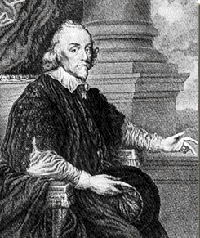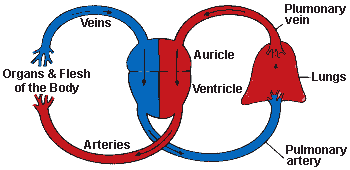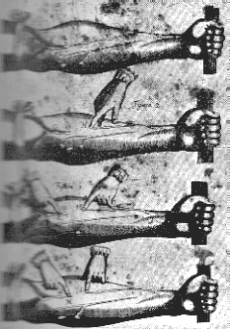 William
Harvey William
Harvey"discoverer
of the circulatory system"
William Harvey was born in
Folkestone, England, on April 1, 1578. After
graduation from Caius College, Cambridge, he
studied medicine at the University of Padua. He
returned to England in 1602, was elected a Fellow
of the College of Physicians in 1607, and in 1609
became a physician at St. Bartholomew's Hospital.
Quickly earning a good reputation for himself, he
was appointed by the College its Lumleian
lecturer in 1615, and by 1618 he was one of the
physicians for both James I and Charles I.
Harvey began his work on the
human circulatory system while at the College of
Physicians. Common teaching at the time held that
the blood moved backward and forward like the ebb
and flow of the tides. It was believed that one
kind of blood was made in the liver, and another
kind in the heart. Arteries were believed to
carry air to all parts of the body, and that the
veins carried the blood. Fabricius, one of
Harvey's former teachers, had discovered the
valves in the large veins, but had failed to
understand their function. Harvey approached the
problem without preconceptions, devising a series
of experiments in which he tied up the blood
vessels of living animals.
 Harvey's observations and experiments
showed that the heart, by repeated contractions, produces a
continuous stream of blood throughout the body
which continually returns to its source (the
heart). Harvey was also able to show that there
had to be pathways at the extremities for the
blood to pass from arteries to veins -- what we
now know as capillaries. Lastly, he showed that
the valves in the veins always direct blood back
to the heart, as opposed to the contemporary
theory that they acted to prevent the lower parts
of the body from flooding with blood. Harvey's observations and experiments
showed that the heart, by repeated contractions, produces a
continuous stream of blood throughout the body
which continually returns to its source (the
heart). Harvey was also able to show that there
had to be pathways at the extremities for the
blood to pass from arteries to veins -- what we
now know as capillaries. Lastly, he showed that
the valves in the veins always direct blood back
to the heart, as opposed to the contemporary
theory that they acted to prevent the lower parts
of the body from flooding with blood.
 Left: This series of drawings shows
how Harvey proved that blood circulates around
the body in the same direction. By constricting
the arm above the elbow the veins stand out and
the valves are seen as swellings. Fingertip
pressure applied to the vein causes that portion
of the vein up to the next valve to be drained of
blood. Left: This series of drawings shows
how Harvey proved that blood circulates around
the body in the same direction. By constricting
the arm above the elbow the veins stand out and
the valves are seen as swellings. Fingertip
pressure applied to the vein causes that portion
of the vein up to the next valve to be drained of
blood.
Harvey published his
observations in An Anatomical Treatise on the
Motion of the Heart and Blood in Animals, in
1628. Although his theories were severely
attacked by followers of the ancient Greek
physician Galen, they
were hard to disprove since they were based on
actual observation and experiment. Harvey lived
to see his discovery widely accepted, although he
did not receive full credit until after his
death.
Ill health forced Harvey to
withdraw from active life in his later years. He
died of a stroke on June 3, 1657, and was buried
in a family vault at Hempstead Church in Essex.
His personal library, which he gave to the
College of Physicians, was lost in the Great Fire
of London in 1666.

James I
Charles I
Heart
Galen
Questions or comments about
this page?
|



